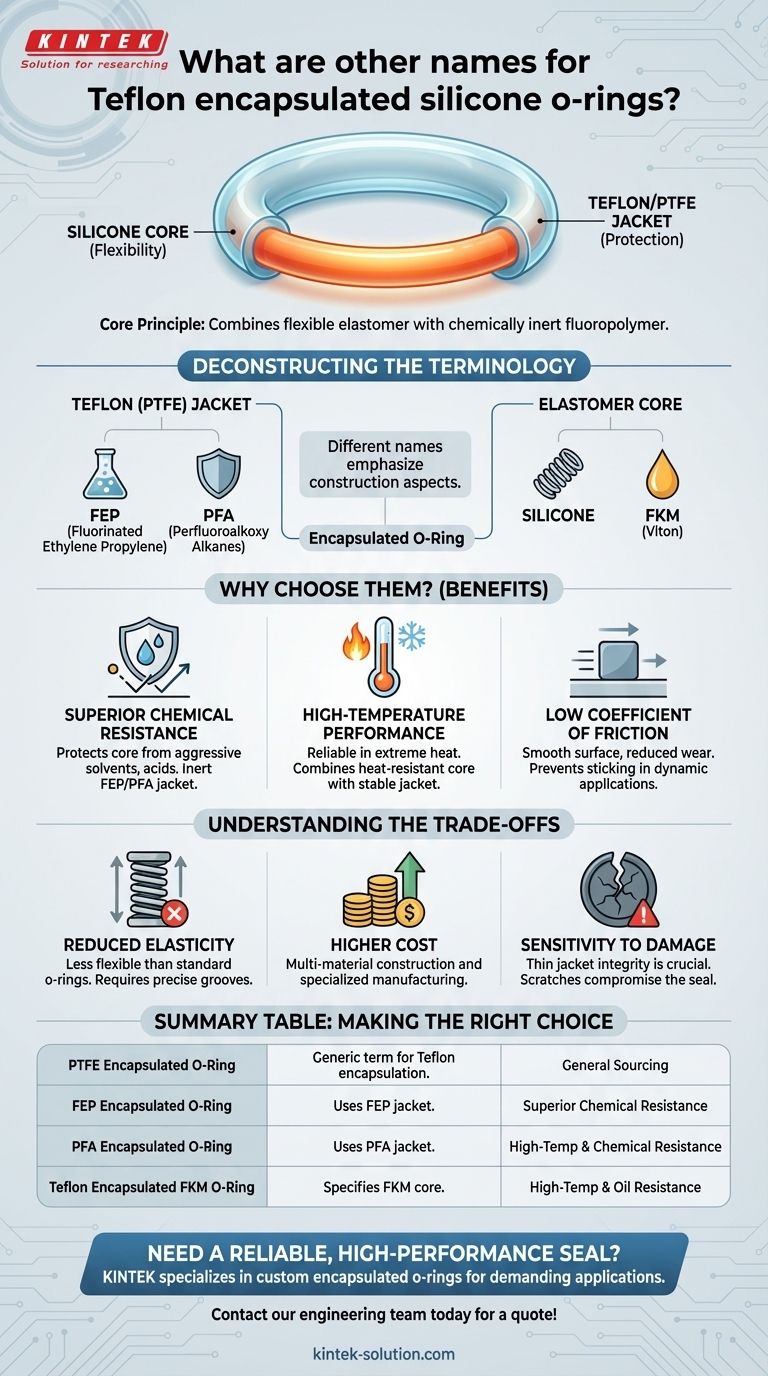The most common alternative name for a Teflon encapsulated silicone o-ring is a PTFE encapsulated o-ring. Because "Teflon" is a specific brand name for the chemical Polytetrafluoroethylene (PTFE), the terms are often used interchangeably in technical and industrial contexts.
The core principle is combining two materials: a flexible elastomer core like silicone for compressibility and a chemically inert fluoropolymer jacket (like Teflon FEP or PFA) for protection against harsh environments.

Deconstructing the Terminology
Understanding the name of this component requires breaking it down into its constituent parts. The different names simply emphasize different aspects of its construction.
The "Teflon" vs. "PTFE" Jacket
Teflon is the registered trademark for a family of fluoropolymer resins, most famously PTFE. In engineering, it's more precise to refer to the specific material.
The seamless outer jacket is typically made of FEP (Fluorinated Ethylene Propylene) or PFA (Perfluoroalkoxy Alkanes), which are specific types of Teflon resins that can be melt-processed to create the seamless encapsulation.
Therefore, you will see names like FEP encapsulated or PFA encapsulated o-rings when a specific material grade is required.
The Elastomer Core
While your query specified a silicone core, this is not the only option available. The core provides the flexibility and "memory" for the seal.
The two most common core materials are silicone and FKM (often known by the brand name Viton). A part might be generically called an "encapsulated o-ring" without specifying the core material.
Why Choose an Encapsulated O-Ring?
These components are designed to solve a specific problem: sealing applications where a standard elastomeric o-ring would fail due to chemical attack or friction.
Superior Chemical Resistance
The outer FEP or PFA jacket is almost completely chemically inert. This protects the vulnerable inner silicone or FKM core from aggressive solvents, acids, and other chemicals.
High-Temperature Performance
By combining a temperature-resistant core like silicone with a stable Teflon jacket, these o-rings can function reliably in high-temperature industrial and automotive applications.
Low Coefficient of Friction
The Teflon surface is extremely smooth and has a very low friction coefficient. This reduces wear and tear during installation and in dynamic applications, preventing sticking and abrasion.
Understanding the Trade-offs
While highly effective, encapsulated o-rings are not a universal solution. Their unique construction introduces specific limitations.
Reduced Elasticity
The rigid outer jacket significantly reduces the o-ring's flexibility and compressibility compared to a standard, solid elastomer o-ring. This means they require more precise groove designs and may not seal as effectively in non-standard or imperfect hardware.
Higher Cost
The multi-material construction and specialized manufacturing process make encapsulated o-rings more expensive than their single-material counterparts.
Sensitivity to Damage
The protective benefit of the o-ring depends entirely on the integrity of the thin outer jacket. Any scratch or damage during installation can create a leak path, compromising the entire seal.
Making the Right Choice for Your Goal
When searching for or specifying these parts, using the right terminology is key to getting the component you need.
- If your primary focus is general sourcing: Use the terms "Teflon encapsulated o-ring" and "PTFE encapsulated o-ring" to get the widest range of results.
- If your primary focus is chemical compatibility: Specify "FEP encapsulated" or "PFA encapsulated" based on the specific chemicals in your application.
- If your primary focus is temperature range: Ensure you specify the core material, such as "Teflon encapsulated silicone o-ring," as silicone and FKM have different thermal properties.
Knowing these variations ensures you can find and specify the exact high-performance seal your project requires.
Summary Table:
| Term | Description | Common Use Case |
|---|---|---|
| PTFE Encapsulated O-Ring | Generic term for Teflon-type encapsulation. | General sourcing, interchangeable with "Teflon". |
| FEP Encapsulated O-Ring | Uses Fluorinated Ethylene Propylene jacket. | Superior chemical resistance. |
| PFA Encapsulated O-Ring | Uses Perfluoroalkoxy Alkanes jacket. | High-temperature and chemical resistance. |
| Teflon Encapsulated FKM O-Ring | Specifies a Viton® (FKM) core. | High-temperature and oil resistance applications. |
Need a Reliable, High-Performance Seal for a Demanding Application?
KINTEK specializes in manufacturing precision PTFE components, including custom encapsulated o-rings for the semiconductor, medical, laboratory, and industrial sectors. We combine expert material knowledge with precision production to deliver seals that offer superior chemical resistance, high-temperature performance, and low friction.
Whether you need a standard PTFE encapsulated silicone o-ring or a custom solution with a specific FEP or PFA jacket, we can fabricate from prototypes to high-volume orders to meet your exact specifications.
Contact our engineering team today to discuss your application requirements and get a quote!
Visual Guide

Related Products
- Custom PTFE Parts Manufacturer for Teflon Parts and PTFE Tweezers
- Custom PTFE Parts Manufacturer for Teflon Containers and Components
- Custom PTFE Sealing Tapes for Industrial and High Tech Applications
- Customizable PTFE Rods for Advanced Industrial Applications
- Custom PTFE Measuring Cylinders for Advanced Scientific and Industrial Applications
People Also Ask
- What industrial benefits do PTFE-machined parts offer? Achieve Peak Performance in Demanding Applications
- What fabrication services are available for PTFE? Shearing, Stamping, Laser Cutting, Molding & Machining
- What are the unique properties of PTFE? The 3 Pillars Driving Demand for High-Performance Parts
- What factors should be considered when choosing between Nylon and PTFE? Select the Right Material for Your Application
- What challenges arise when machining PTFE (Teflon)? Overcome Softness, Heat, and Instability



















